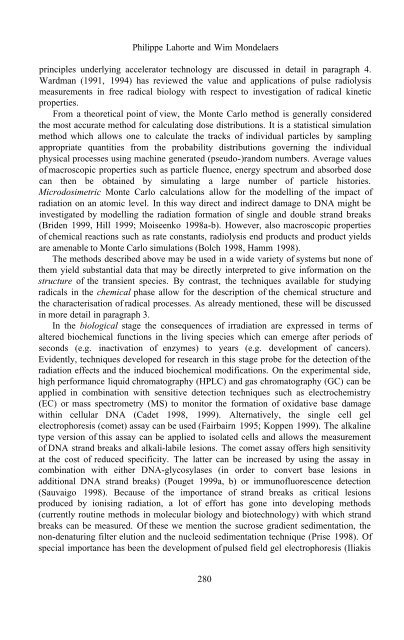Physics And Chemistry Basis Of Biotechnology - De Cuyper - tiera.ru
Physics And Chemistry Basis Of Biotechnology - De Cuyper - tiera.ru
Physics And Chemistry Basis Of Biotechnology - De Cuyper - tiera.ru
You also want an ePaper? Increase the reach of your titles
YUMPU automatically turns print PDFs into web optimized ePapers that Google loves.
Philippe Lahorte and Wim Mondelaers<br />
principles underlying accelerator technology are discussed in detail in paragraph 4.<br />
Wardman (1991, 1994) has reviewed the value and applications of pulse radiolysis<br />
measurements in free radical biology with respect to investigation of radical kinetic<br />
properties.<br />
From a theoretical point of view, the Monte Carlo method is generally considered<br />
the most accurate method for calculating dose distributions. It is a statistical simulation<br />
method which allows one to calculate the tracks of individual particles by sampling<br />
appropriate quantities from the probability distributions governing the individual<br />
physical processes using machine generated (pseudo-)random numbers. Average values<br />
of macroscopic properties such as particle fluence, energy spect<strong>ru</strong>m and absorbed dose<br />
can then be obtained by simulating a large number of particle histories.<br />
Microdosimetric Monte Carlo calculations allow for the modelling of the impact of<br />
radiation on an atomic level. In this way direct and indirect damage to DNA might be<br />
investigated by modelling the radiation formation of single and double strand breaks<br />
(Briden 1999, Hill 1999; Moiseenko 1998a-b). However, also macroscopic properties<br />
of chemical reactions such as rate constants, radiolysis end products and product yields<br />
are amenable to Monte Carlo simulations (Bolch 1998, Hamm 1998).<br />
The methods described above may be used in a wide variety of systems but none of<br />
them yield substantial data that may be directly interpreted to give information on the<br />
st<strong>ru</strong>cture of the transient species. By contrast, the techniques available for studying<br />
radicals in the chemical phase allow for the description of the chemical st<strong>ru</strong>cture and<br />
the characterisation of radical processes. As already mentioned, these will be discussed<br />
in more detail in paragraph 3.<br />
In the biological stage the consequences of irradiation are expressed in terms of<br />
altered biochemical functions in the living species which can emerge after periods of<br />
seconds (e.g. inactivation of enzymes) to years (e.g. development of cancers).<br />
Evidently, techniques developed for research in this stage probe for the detection of the<br />
radiation effects and the induced biochemical modifications. On the experimental side,<br />
high performance liquid chromatography (HPLC) and gas chromatography (GC) can be<br />
applied in combination with sensitive detection techniques such as electrochemistry<br />
(EC) or mass spectrometry (MS) to monitor the formation of oxidative base damage<br />
within cellular DNA (Cadet 1998, 1999). Alternatively, the single cell gel<br />
electrophoresis (comet) assay can be used (Fairbairn 1995; Koppen 1999). The alkaline<br />
type version of this assay can be applied to isolated cells and allows the measurement<br />
of DNA strand breaks and alkali-labile lesions. The comet assay offers high sensitivity<br />
at the cost of reduced specificity. The latter can be increased by using the assay in<br />
combination with either DNA-glycosylases (in order to convert base lesions in<br />
additional DNA strand breaks) (Pouget 1999a, b) or immunofluorescence detection<br />
(Sauvaigo 1998). Because of the importance of strand breaks as critical lesions<br />
produced by ionising radiation, a lot of effort has gone into developing methods<br />
(currently routine methods in molecular biology and biotechnology) with which strand<br />
breaks can be measured. <strong>Of</strong> these we mention the sucrose gradient sedimentation, the<br />
non-denaturing filter elution and the nucleoid sedimentation technique (Prise 1998). <strong>Of</strong><br />
special importance has been the development of pulsed field gel electrophoresis (Iliakis<br />
280












